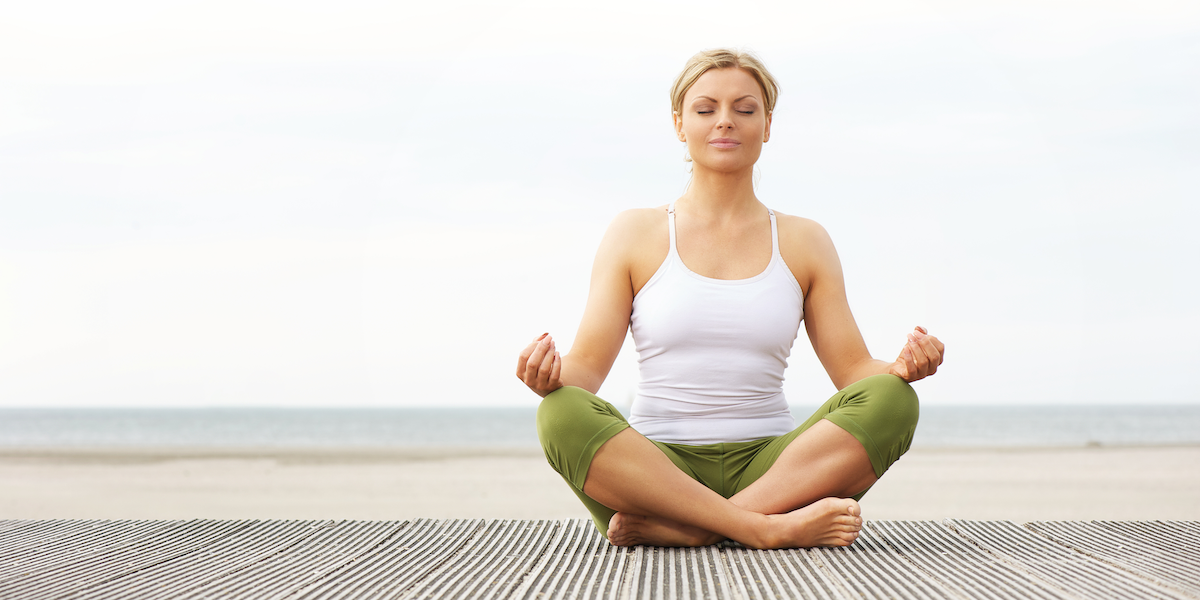When you want to get stronger or improve your endurance, you lift weights or take up jogging, and you don’t just do it once. You incorporate physical exercise into your daily routine.
Table of Contents
- What Is Meditation?
- Why Learn to Meditate?
- How to Start Meditating
- How Does Meditation Work?
- What Do I Need to Start Meditating?
- What to Expect in a Meditation Session
- Top Meditation Tips and Techniques for Beginners
- What are the Different Types of Meditation Styles
Meditation is a form of mental exercise. When you meditate, you learn how to pay attention to your breathing and refocus your mind when it drifts off in another direction. In essence, you’re building mindfulness muscles.
Like other forms of exercise, meditation requires consistent practice. It also provides several significant benefits, including lower stress levels, improved physical health, and better sleep quality. It helps you pay better attention to the here and now, rather than worrying about the future or dwelling on the past.
Have you been thinking about learning how to meditate? By the end of this article, you will be more aware of what meditation is and ready to get started!
If you prefer to get started with a private session or group class, visit Sofia Health to get started.
What Is Meditation?
Let’s start with what meditation isn’t (or at least, is not always). Meditation isn’t just sitting still and emptying all of the thoughts from your mind. That’s a common misconception. When you meditate, you aren’t trying to shut off your mind. Instead, you’re spending time with it.
So, what is meditation? Have you ever been driving along when a fancy car passes by and grabs your attention? Or maybe you were looking for something online when a brightly colored ad catches your eye, so you click on it instead. The next thing you know, you’re on a strange road or a webpage for something completely unrelated to your initial search.
These instances aren’t unlike our thoughts. Sometimes, a thought will enter your mind that commands your full attention. You get caught up analyzing it or lost in a daydream. Other times, you find yourself trying (with little success) to push it from your mind. You can get so distracted that you lose track of time or forget what you were doing before.
Meditation trains us to notice the fancy car or eye-catching ad and, rather than follow it, let it go. The more we practice, the easier it becomes. We’re able to let our distracting thoughts go and, in essence, get out of our own heads. In doing so, we become more present and engaged in what we’re doing at that moment, whether that’s spending time with family, completing a project for work or school, or simply taking some time for ourselves.
Want an in-depth overview of meditation, check out our article 'What is Meditation'.
Why Learn to Meditate?
People choose to learn and practice meditation for many reasons. Let’s take a look at some of the most common ones:
1. Promote Mental and Emotional Health
Constant stress and worry can take a significant toll on your mental health. These factors can lead to anxiety, depression, and poor self-image.
While it isn’t a cure-all, meditation can help promote better mental and emotional health. It increases awareness, boosts mental clarity, and promotes a sense of calm. Several studies show that the practice helps manage stress and reduce symptoms of anxiety and depression. Some forms of meditation can help you learn to recognize harmful or self-defeating thoughts, allowing you to take control of them (rather than letting them control you).
2. Boost Physical Health
Being under constant stress can affect your physical health, too. It can increase your risk of cardiovascular issues (such as high blood pressure), poor immune function, digestive health problems, and muscle pain. Meditation’s stress-reducing benefits can help reduce your risk of these and other stress-related health complications, which can help to boost your overall physical health.
Meditation can also help ease pain not related to stress. Along with reducing pain intensity, it can help maintain those improvements over time.
3. Enhance Focus and Attention Span
Many factors can contribute to poor focus and a limited attention span. Some are related to anxiety, depression, and other mental health concerns. Others may be related to too many distractions or trying to take on too much at once (multitasking).
Several studies have found that regular meditation improves the ability to focus. It can also lengthen your attention span and keep your mind from wandering. Better focus and attention can then boost your productivity.
On a related note, meditation may also help stave off age-related memory loss. It may even provide slight memory improvements in older adults already living with dementia.
4. Strengthen Connections
Meditation improves mood regulation, empathy, and acceptance. These benefits can go a long way in improving relationships with partners, family members, and friends.
As mentioned above, meditation increases your awareness of your thoughts and feelings. That provides insight into your tendencies, such as snapping when you feel threatened. Recognizing a tendency or habit is often enough to spark positive changes.
5. Improve Sleep Quality
Getting quality sleep is essential for maintaining your overall health and wellness. However, stress, anxiety, and pain can make falling and staying asleep difficult. Other factors like an irregular sleep schedule, screen exposure right before crawling into bed, and wandering thoughts can also contribute. Studies indicate that meditating before bed promotes relaxation, reduces time spent lying awake, and improves sleep quality.
To learn more about the benefits of meditation, check out our article, Top 10 Science-Based Benefits of Meditation.
How to Start Meditating
While there are many different forms of meditation (several of which we’ll explore later on), let’s go over the basic steps to get you started:
- Find a comfortable place to sit. Sitting cross-legged on the floor is one of the most common postures for meditation. However, you can sit in a chair if it’s easier for you. The most important thing is that you remain comfortable. Pay attention to how your body feels.
- Give yourself a time limit. Meditation doesn’t require a lot of time out of your day. Start with five to ten-minute sessions. As you grow more comfortable, you can increase your practice time.
- Pay attention to your breathing. Inhale slowly and deeply, filling your belly with your breath. Exhale slowly. As you do this, take note of how each breath feels.
- Keep an eye on your thoughts. There’s a good chance that your mind will wander while you meditate, and that’s okay. When you notice your thoughts straying away from your breathing, avoid judgment or trying to analyze them. Instead, gently bring them back to your breathing
- Close your session. As you end your practice, open or lift your eyes and take a moment to notice your surroundings and yourself. What do you hear? How does your body feel? What about your mind?
That’s all there is to it. Now, you may notice that although it is often simple, meditation can also be challenging. It only takes a few minutes, but it takes commitment. After all, meditation is a skill. Learning how to do it requires consistent practice. The more you practice, the more comfortable you’ll become. Often, the most important part of meditation is sitting down to start.
How Does Meditation Work?
There are a lot of things in life we can’t control. What we can control is how we relate or react to those things. That’s where a practice like meditation comes in.
When you meditate, you allow yourself an opportunity to calm your mind and see things more clearly. You give yourself time to observe your thoughts, feelings, and behaviors, which can help you discover patterns you might not have known about before. Meditation won’t turn you into a new or different person, but it can help you adjust how you perceive and react to the world around you.
Essentially, meditation is like a personal wellness check. You take a few minutes out of your day to see how you’re doing. At the same time, you’re slowing down and focusing on the present moment rather than what might happen in the future.
What Do I Need to Start Meditating?
Meditation doesn’t require much. You don’t have to buy any special, expensive equipment, nor do you need to go anywhere to practice. Even so, there are a few things you’ll need to get started:
Time
Even if it’s only a few minutes, meditation requires deliberately taking some time out of your day to do it. The time of day doesn’t matter. What does matter is that you find a time of day (and length of time) that works best with your schedule and lifestyle?
Meditation also requires consistency, ideally, daily. When you meditate every day, it becomes a habit or part of your regular routine. It also helps you unlock the most benefits out of your practice. However, don’t beat yourself up if you miss a day or two. Remember, part of meditation is being kind to yourself. You can always jump right back in where you left off.
Space
One of the best things about meditation is that you can do it anywhere. You only need a space where you can sit with minimal distractions. Keep in mind that “minimal distractions” don’t mean total silence. In fact, some people find it harder to meditate in such conditions. White noise or soft, soothing music can be helpful.
Comfort
No matter where you sit to meditate, you want to ensure you’ll be comfortable for the duration of your practice. If the bare floor is too hard, try using a yoga mat or cushion. Or, you can avoid the floor altogether by sitting in a chair. It’s about what works best for you. To that end, you might also find you meditate best when wearing looser clothing and minimal accessories.
What to Expect in a Meditation Session
While your meditation sessions are likely to be different, there are a few things you can expect to happen:
- Your mind may stray. It’s normal for your thoughts to wander in different directions while you meditate. It happens to everyone, even those who have been practicing for years. All you need to do is gather them back up and refocus them on your breathing.
- You might have trouble sitting still. Interruptions could include an itch on your arm, a sudden desire to shift your legs, or the unconscious tapping of your fingers. Much like wandering thoughts, these distractions are incredibly common. Treat them in a similar manner. Acknowledge them, let them go, and refocus.
- You may suddenly get sleepy. Don’t be surprised if you start to nod off in the early days of learning to meditate. Your mind needs a little time to adjust to the new habit and learn that you’re only trying to slow down, not fall asleep. However, if you’re meditating before bed, that relaxation can make it easier to fall asleep when you finally lay down.
- You might feel a lot or nothing at all. When your mind is constantly busy, it doesn’t often have time to deal with emotions. Suddenly slowing down can bring them all to the surface. Don’t try to stuff them back down. Instead, acknowledge them and let them go. At the same time, you might not feel anything at first. That’s okay, too. You aren’t doing anything wrong. Keep checking in with yourself every day.
- You might try to be “perfect.” You might try to shut off your thoughts or get frustrated that they wander so much. Remember, meditation isn’t about perfecting something. These things are all part of the experience. Be kind to yourself. With daily practice, you’ll find it easier to get yourself back on track.
If you find yourself struggling, don’t give up.
Top Meditation Tips and Techniques for Beginners
Are you almost ready to get started? Here are a few top tips on how to meditate for beginners:
- Start small. Acclimate your mind to meditation. If ten minutes is too much, start with three to five.
- Practice daily. Meditating every day will help you form a habit. It’ll become easier, and you’ll get the most benefits out of it. If you have trouble remembering, leave yourself a reminder, such as a yoga mat on the floor or a funny sticky note on your bathroom mirror.
- Try guided meditation. With guided meditation, someone else leads you through a meditation exercise. While anyone can use guided meditation, beginners may find this particularly helpful
- Remember, there’s no such thing as “perfect” meditation. Just by showing up and practicing, you’re doing great.
What are the Different Types of Meditation Styles?
There are many popular styles of meditation. Here are the top six. For a full list, see our in-depth exploration of nine popular types of meditation here.
1. Mindfulness Meditation
Mindfulness meditation is one of the most well-known styles. It’s the one that teaches you to focus on the present rather than the past or future. You learn to observe your thoughts and feelings without judgment.
2. Focused Meditation
Focused or concentration meditation involves giving yourself a single point of focus. Typically, that’s your breathing. However, in some practices, that focus could be a mantra, the sound of a gong, or a candle flame. Any time your mind wanders, you redirect it back to the focus point.
3. Visualization Meditation
Visualization is a type of focused meditation. Instead of your breath, your focus becomes a particular thing or person. With this type of meditation, you can observe your mind and any physical sensations you feel when you imagine the object or person. It can help you let go of negative feelings or manifest the things you want in life.
4. Body Scan Meditation
Over time, our minds and bodies can become disconnected. Body scan meditation seeks to resynchronize them. When you meditate, you begin with your focus at the top of your head and slowly work your way down to the tips of your toes (or vice versa). As you do this, take note of any sensations, tension, or pain you feel.
5. Transcendental Meditation
The practice of Transcendental Meditation involves focusing on a mantra, a particular word or phrase, that a certified practitioner provides. You repeat your mantra silently to yourself as you breathe. It’s a well-researched method of meditation that helps you go beyond (transcend) the boundaries of your mind and clear it of distracting thoughts.
6. Movement Meditation
Not all meditation involves sitting still. Movement meditation is an active form that uses gentle movements and breathing to guide you to a deeper connection with the present moment. While many people typically associate yoga with movement meditation, this practice also includes tai-chi and qigong.
Want to Know More? Book a Session With a Meditation Coach
Regular meditation provides a whole host of benefits, from gaining a better understanding of your thoughts and feelings to improving your overall mental and physical health. What’s more, you don’t need fancy equipment, an expensive gym membership, or even a lot of time. All you need is a quiet, comfortable space to practice and a few minutes a day.
Do you want to learn more about the benefits of meditating daily and how to get started?
Book a consultation with a meditation coach on Sofia Health today!
Learn more about meditation
|
|
|








